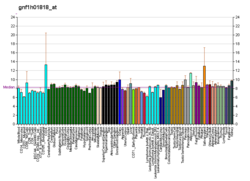Gem-associated protein 5 is a protein that in humans is encoded by the GEMIN5 gene .[ 5] [ 6]
^ a b c GRCh38: Ensembl release 89: ENSG00000082516 – Ensembl , May 2017^ a b c GRCm38: Ensembl release 89: ENSMUSG00000037275 – Ensembl , May 2017^ "Human PubMed Reference:" . National Center for Biotechnology Information, U.S. National Library of Medicine .^ "Mouse PubMed Reference:" . National Center for Biotechnology Information, U.S. National Library of Medicine .^ a b c Gubitz AK, Mourelatos Z, Abel L, Rappsilber J , Mann M, Dreyfuss G (Feb 2002). "Gemin5, a novel WD repeat protein component of the SMN complex that binds Sm proteins" . J Biol Chem . 277 (7): 5631–6. doi :10.1074/jbc.M109448200 PMID 11714716 . ^ a b "Entrez Gene: GEMIN5 gem (nuclear organelle) associated protein 5" .^ Mourelatos Z, Dostie J, Paushkin S, Sharma A, Charroux B, Abel L, Rappsilber J, Mann M, Dreyfuss G (Mar 2002). "miRNPs: a novel class of ribonucleoproteins containing numerous microRNAs" . Genes Dev . 16 (6): 720–8. doi :10.1101/gad.974702 . PMC 155365 PMID 11914277 .
Baccon J, Pellizzoni L, Rappsilber J, Mann M, Dreyfuss G (2002). "Identification and characterization of Gemin7, a novel component of the survival of motor neuron complex" . J. Biol. Chem . 277 (35): 31957–62. doi :10.1074/jbc.M203478200 PMID 12065586 . Beausoleil SA, Jedrychowski M, Schwartz D, Elias JE, Villén J, Li J, Cohn MA, Cantley LC, Gygi SP (2004). "Large-scale characterization of HeLa cell nuclear phosphoproteins" . Proc. Natl. Acad. Sci. U.S.A . 101 (33): 12130–5. Bibcode :2004PNAS..10112130B . doi :10.1073/pnas.0404720101 PMC 514446 PMID 15302935 . Kimura K, Wakamatsu A, Suzuki Y, Ota T, Nishikawa T, Yamashita R, Yamamoto J, Sekine M, Tsuritani K, Wakaguri H, Ishii S, Sugiyama T, Saito K, Isono Y, Irie R, Kushida N, Yoneyama T, Otsuka R, Kanda K, Yokoi T, Kondo H, Wagatsuma M, Murakawa K, Ishida S, Ishibashi T, Takahashi-Fujii A, Tanase T, Nagai K, Kikuchi H, Nakai K, Isogai T, Sugano S (2006). "Diversification of transcriptional modulation: Large-scale identification and characterization of putative alternative promoters of human genes" . Genome Res . 16 (1): 55–65. doi :10.1101/gr.4039406 . PMC 1356129 PMID 16344560 . Battle DJ, Lau CK, Wan L, Deng H, Lotti F, Dreyfuss G (2006). "The Gemin5 protein of the SMN complex identifies snRNAs" . Mol. Cell . 23 (2): 273–9. doi :10.1016/j.molcel.2006.05.036 PMID 16857593 . Beausoleil SA, Villén J, Gerber SA, Rush J, Gygi SP (2006). "A probability-based approach for high-throughput protein phosphorylation analysis and site localization". Nat. Biotechnol . 24 (10): 1285–92. doi :10.1038/nbt1240 . PMID 16964243 . S2CID 14294292 . Olsen JV, Blagoev B, Gnad F, Macek B, Kumar C, Mortensen P, Mann M (2006). "Global, in vivo, and site-specific phosphorylation dynamics in signaling networks" . Cell . 127 (3): 635–48. doi :10.1016/j.cell.2006.09.026 PMID 17081983 . S2CID 7827573 . Kim EK, Noh KT, Yoon JH, Cho JH, Yoon KW, Dreyfuss G, Choi EJ (2007). "Positive regulation of ASK1-mediated c-Jun NH(2)-terminal kinase signaling pathway by the WD-repeat protein Gemin5" . Cell Death Differ . 14 (8): 1518–28. doi :10.1038/sj.cdd.4402157 PMID 17541429 . Hao le T, Fuller HR, Lam le T, Le TT, Burghes AH, Morris GE (2007). "Absence of gemin5 from SMN complexes in nuclear Cajal bodies" . BMC Cell Biol . 8 : 28. doi :10.1186/1471-2121-8-28 PMC 1939999 PMID 17640370 . Battle DJ, Kasim M, Wang J, Dreyfuss G (2007). "SMN-independent subunits of the SMN complex. Identification of a small nuclear ribonucleoprotein assembly intermediate" . J. Biol. Chem . 282 (38): 27953–9. doi :10.1074/jbc.M702317200 PMID 17640873 .






